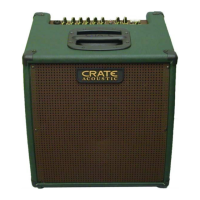CA6110D Acoustic Amplifier
6
One of the most common problems encountered when amplifying
acoustic instruments, especially in small environments, is feedback.
Acoustic instruments typically have inherent qualities which cause reso-
nant feedback at specific frequencies. Instrument tone controls and sound
board equalizers are helpful in getting rid of the problem, but they typi-
cally operate around relatively wide frequency bands. This almost always
means the musician must sacrifice sound quality in his quest to do away
with feedback. But since Crate’s feedback elimination circuit isolates only
the offending frequency, instrument feedback from the CA6110D can be
eliminated without affecting the overall sound.
If you experience feedback while playing, depress the Feedback Filters On
switch. This actives the automatic feedback control circuit. Depress the
Feedback Filter 1 switch to isolate and control the offending frequency. If
feedback occurs again while the Filter 1 switch is depressed, depress the
Filter 2 switch to isolate and control the second offending frequency.
The LEDs above the switches illuminate when the switches are depressed.
When a footswitch is used in the Feefback Filters Footswitch jack (#18),
the ON LED illuminates when the plug is inserted into the jack and the
front panel switches are rendered inoperative.
To Eliminate Instrument Feedback:
The DSP Section:
The CA6110D features Crate’s On-Board Digital Signal Processing
(DSP) technology that was designed specifically for use with
acoustic instruments and vocals. This provides a large selection
of digital reverbs, effects and delays. Select the type of effect
desired by rotating the Mode control (#13). The effects are
described below.
When a footswitch is used in the DSP A/B Back Footswitch jack (#19), a
separate DSP setting can be stored and recalled for each of the
footswitch’s two button positions (LED on, LED off). Refer to the steps on
page 5, item #19.
The following chart provides a list of the DSP settings along with a brief description of
each effect.
Reverb: R average room reverb
S small dark hall reverb
M medium hall reverb
L large hall reverb
Delay: S 100 milisecond delay
M 200 milisecond delay
L1 335 milisecond delay
L2 500 milisecond delay
Rev/Dly: M reverb with 250 milisecond delay
L1 reverb with 400 milisecond delay
L2 reverb with 550 milisecond delay
Multi: Ch1 chorus effect
Ch2 chorus, 375 milisecond delay, reverb
Ch3 425 milisecond delay with chorus, reverb
Dblr adds second signal slightly out of sync with original
Bypass effects “off”

